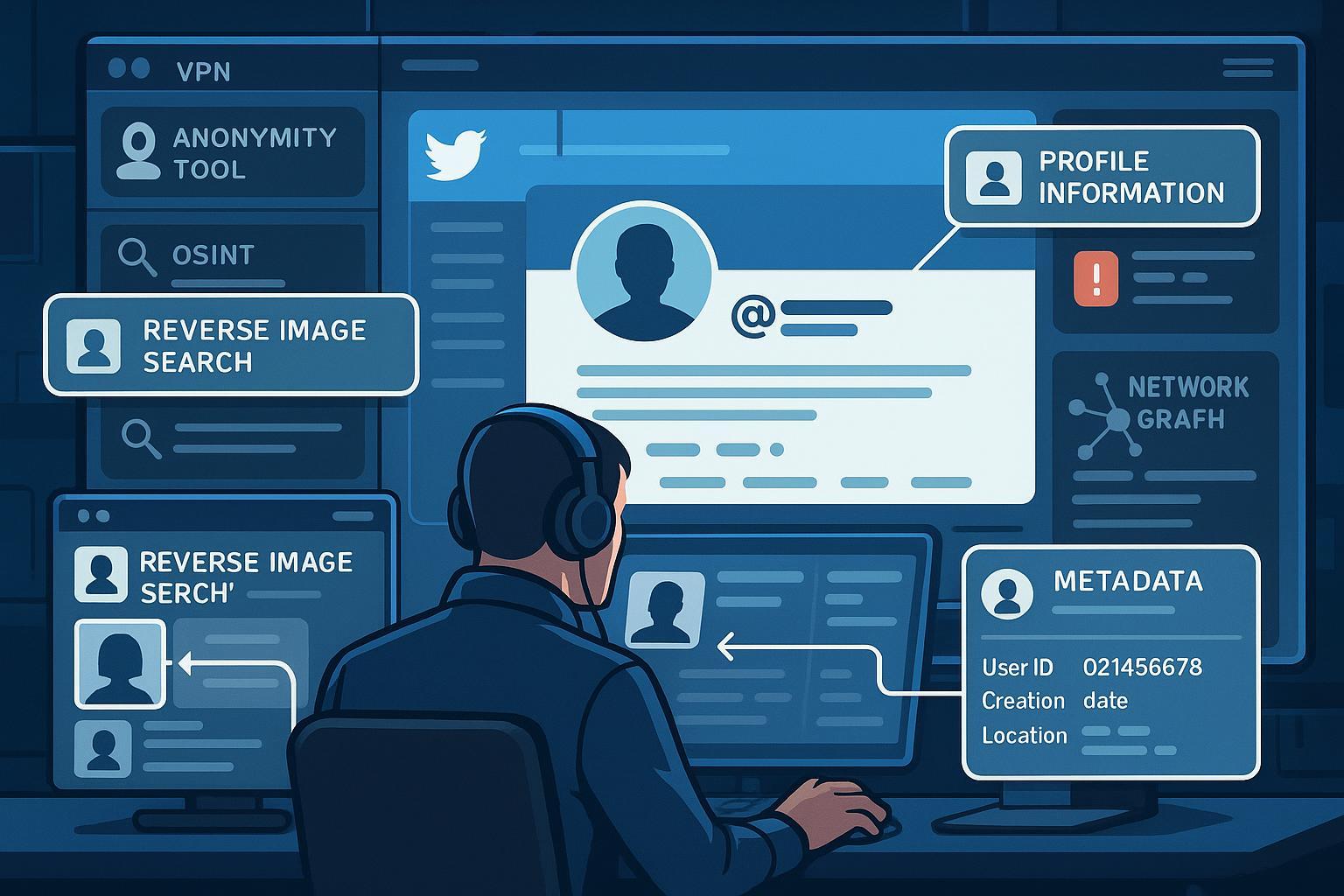How to Find Out Who Is Behind a Twitter Account: The Complete Actionable OSINT Guide

Introduction: What You'll Achieve (and Why Responsibility Matters)
Have you ever encountered a mysterious Twitter (now X) account and wondered who’s really behind it? Whether it’s fact-checking, protecting your brand, or investigating for content creation, uncovering a Twitter user’s real identity requires far more than scrolling their bio. In today’s landscape, powerful Open Source Intelligence (OSINT) techniques make this possible—but they also introduce legal and ethical boundaries you must not cross.
This guide delivers a hands-on, step-by-step workflow (from basics to advanced OSINT) for tracing the owner of a Twitter account—complete with the latest tools, troubleshooting, practical tips, and a reality check on what’s possible (and legal).
Warning: Use all techniques responsibly and never for harassment, doxxing, or illegal use (see ethics/legal section). Not every account can be identified, and privacy must be respected.
Preparation: Set Yourself Up for Success (and Safety)
🛠️ Essential Tools & Materials
A laptop/desktop (multitasking & tools require this)
VPN or proxy for anonymity
Secondary Twitter/X account (in case of viewing limits or blocks)
Modern browser (preferably in private/incognito mode)
Key OSINT tools:
Namechk, KnowEm, WhatsMyName: Username search
Sherlock, SpiderFoot: Cross-platform automation
Google Images, TinEye, Yandex Images: Reverse image search
Social Searcher: Social media monitoring
Archiving tools: Wayback Machine, Archive.ph
✅ Prerequisites & Preparation Checklist
Understand Twitter’s policies and local data privacy laws (GDPR, anti-doxxing, etc.)
Isolate your research (use a virtual machine, if possible)
Record every step (use a note template—for auditing, error recovery, and ethical proof)
Pro Tip: Download this OSINT Investigation Checklist (PDF) for process tracking.
🛡️ Ethical and Legal Boundaries: Read Before You Begin
Stay Legal: Only use information accessible to the general public. No hacking, no bypassing security, no scraping data protected by law.
Stay Ethical: Never harass, threaten, or dox individuals. Always have a research/business/defense reason—never personal vendetta.
For in-depth compliance: Hackers Arise Twitter OSINT Techniques (Ethics & Legality)
Step-by-Step: Practical Workflow to Investigate a Twitter Account
Step 1: Basic Account Profiling (Estimated Time: 5–10 minutes)
Open the target profile in a private browser window.
Examine all public details:
Bio, location, website, join date
Profile image and banner
Follower/following numbers
Pinned tweets, hashtags, links
Screenshot or archive anything interesting early (people frequently delete or lock content).
Pro Tip: Don’t stop at the bio. Key info often hides in usernames, tweet patterns, or followers.
Step 2: Advanced Twitter Search Operators (Time: 5–10 minutes)
Master Twitter Advanced Search using operators:
from:username (their tweets)
to:username (mentions to them)
since:YYYY-MM-DD until:YYYY-MM-DD (date filtering)
near:city or geocode: (location-based)
filter:images/videos/links (narrow post types)
Combine hashtags and keywords to uncover older content
Look for:
Early posts for introductory or personal information
Interactions with friends (may link to real-world connections)
Places or events mentioned that may indicate location
Step 3: Media & Metadata Extraction (Time: 5–15 minutes)
Download/reverse search the profile image, posted photos, banner. Use:
Search4faces for portrait/face search
Check images for EXIF/metadata (location, device, timestamp info) using ExifTool, Metadata2Go, InVID.
If No Matches:
Search cropped, grayscale, or alternate versions
Try social media aggregators (PimEyes, if permitted Jurisdictionally)
Warning: Twitter now strips EXIF on most uploads, but metadata/timestamps sometimes survive (older posts, indirect uploads, other sources).
Step 4: Username, Alias & Cross-Platform Correlation (Time: 10–20 minutes)
Copy the Twitter handle and possible aliases.
Search for reuse across the internet:
Automated tools: Namechk, KnowEm, WhatsMyName
OSINT scripts: Sherlock, SpiderFoot; enter username, review cross-platform presence
Manual check on platforms: Facebook, Instagram, Reddit, YouTube, LinkedIn, niche forums
What to Look For:
Matched or similar accounts with more public/real info
Consistency in photos, banner art, bios to corroborate identity
Email addresses or phone numbers surfaced in other platforms
Pro Tip: Many users recycle usernames and profile images on lesser-known platforms—don’t restrict your search to only the big sites.
If Multiple Matches:
Cross-reference profile image, banner, connections, or posting style
Step 5: Social Network & Activity Pattern Analysis (Time: 10–30 minutes)
Map relationships:
Explore mutuals, original followers, frequent interactors
Use tools: Social Bearing, Maltego, Gephi, Twitonomy
Analyze tweet habits:
Typical posting times (can reveal timezone or daily rhythm)
Spoken language, local slang, references
Flag automation or bot-like behaviors (excessive retweeting, regular intervals)
Look for Early Patterns:
Relationships from the account’s first tweets often trace real-world ties
Anomalies in follower/following may reveal purchased or throwaway accounts
Step 6: Deep Dives—Emails, Phone Lookups & Data Breaches (if available)
If you find an email or phone:
Run it through OSINT databases (Epieos, OSINT Industries, HaveIBeenPwned)
Check for previously linked public records (if permitted)
For advanced users:
Breach search: Use platforms like Dehashed (paid)
Automation: SpiderFoot links multiple leads
Warning: Never pay for or access illegal breach/PII datasets. Public breach notifications only.
Step 7: Archiving, Cross-Validation, and Conclusions (Time: 5–15 minutes)
Archive key content (screenshots, Wayback Machine); evidence can vanish quickly
Confirm attribution with at least two independent, corroborating data points (e.g., email reused on both Twitter and LinkedIn, posting times match geolocation clue, or identical bio details)
Log every dead end; if stuck, pivot technique/tool or consider ending ethically
Troubleshooting and Pro-Tips: Avoid Mistakes, Recover from Dead Ends
❌ Common Dead Ends & Recovery
Sparse profiles: Pivot to analyzing network/followers or deeper image/username methods
No reverse image matches: Try alternate crops or focus on images posted in tweets, not just profile
Private or locked accounts: Scrutinize mentions, retweets, and public interactions
Multiple matching usernames: Use cross-referencing—match images, bio, linked accounts, or interaction style
⚠️ Professional Warnings & Expert Recommendations
Document everything: For both recovery and to demonstrate ethical boundaries
Never trust single-source evidence: Always double/triangulate findings
Expect 40–80% success: Many accounts remain untraceable due to strong privacy tactics
If legality is unclear, STOP and seek guidance.
FAQ (Quick Answers)
Q: Is it legal to use OSINT tools on Twitter accounts?
A: Generally, yes—if you only access public data, never scrape/password-bypass, and follow jurisdictional privacy laws.
Q: What if I hit repeated dead ends?
A: Try alternate tools and platforms; sometimes results appear with a different approach (or after account activity).
Q: Are paid tools necessary?
A: For basic attribution, no. For deep-dives (data breach, network mapping), yes—especially on obfuscated accounts.
Q: Can all Twitter accounts be linked to a real-world identity?
A: No. Success rates drop for users using privacy tools/fake info. Most guides report a 40–60% success with advanced OSINT, up to 85% in simple, data-rich cases.
Wrap-Up: Your Responsible OSINT Playbook
You’ve now learned:
How to systematically investigate a Twitter account using beginner-to-advanced OSINT tools
How to cross-reference, validate, and avoid common pitfalls
The importance of documenting ethically and recognizing when to stop
Major Takeaway: Diligent researchers often succeed when combining multi-platform OSINT, image analysis, and behavioral clues—but respecting privacy and legality is non-negotiable.
Want to Level Up Further?
Stay sharp, stay ethical—and good luck with your investigations!

